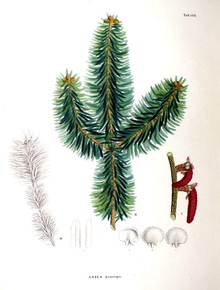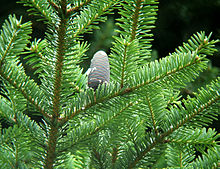Nikko fir
| Nikko fir | ||||||||||||
|---|---|---|---|---|---|---|---|---|---|---|---|---|

Nikko fir ( Abies homolepis ) |
||||||||||||
| Systematics | ||||||||||||
|
||||||||||||
| Scientific name | ||||||||||||
| Abies homolepis | ||||||||||||
| Sieve. & Zucc. |
The Nikko fir ( Abies homolepis ) is a type of plant from the genus of firs ( Abies ) within the pine family (Pinaceae). It is native to Japan .
description

Vegetative characteristics
The Nikko fir is an evergreen tree that reaches heights of 25 to 40 meters and a trunk circumference of 1 to 5 meters. It has a relatively broad and loose, pyramidal crown , which is formed by branches extending horizontally from the trunk. The bark is small-scale and has a reddish-gray to dark purple-gray color. The color of the deeply furrowed bark of the branches ranges from gray to brown to a yellowish brown with a pink tinge.
With a size of 10 to 14 millimeters, the conical-egg-shaped buds are partially covered by the needles , are brown in color and covered by a white resin layer. The needles are arranged in a V-shape on the top of the branch, while they come off horizontally on the underside of the branch. The needles are between 1 and 3 inches long and 2 to 2.5 millimeters wide. The needles are glossy dark green on top and bluish-white on the underside. At the base they are twisted, and the tip of the needle is blunt or divided in two. Six to eight stomatal ligaments run on the underside of the needle .
Generative characteristics
The Nikko fir is single-sexed ( monoecious ). The egg-shaped male cones with a length of about 1.4 centimeters and a diameter of 7 millimeters are yellowish-green in color. With a length of 7 to 10 centimeters and a diameter of 3 to 4 centimeters, the cylindrical cones are resinous and dark purple to brown in color as they mature. The gray seeds are around 1.8 centimeters tall.
The number of chromosomes is 2n = 24.
Distribution and location
The Nikko fir originally comes from the Japanese islands of Honshū , Kyushu and Shikoku , where it mainly populates the cool mountain regions at altitudes of 700 to 2200 meters. Today it is used worldwide as an ornamental wood for parks and gardens, especially in temperate latitudes .
In its natural location, it forms mixed stands together with other trees that are adapted to the cold, such as the Japanese pine ( Pinus parviflora ), the Japanese yew ( Taxus cuspidata ), the Japanese arborvitae ( Thuja standishii ) and the northern Japanese hemlock ( Tsuga diversifolia ).
Systematics
The first description of Abies homolepis was carried out in 1842 by Philipp Franz of Siebold and Joseph Gerhard Zuccarini in Flora Japonica , 2, pp 17, panel 108. The Nikko fir is within the genus of the fir ( Abies ) in the section Momi and the lower section Homolepoides posed. A synonym for Abies homolepis sieve. & Zucc. is Abies brachyphylla Maxim.
One can distinguish two varieties, both of which occur in central and southern Japan:
- Abies homolepis var. Homolepis
- Abies homolepis var. Umbellata (Mayr) EHWilson (Syn .: Abies umbellata Mayr ).
Hazard and protection
The Nikko fir is classified as "not endangered" in the IUCN Red List . However, the IUCN advises that a renewed assessment of the risk is necessary.
swell
- Christopher J. Earle: Information on Abies homolepis at The Gymnosperm Database , 2010. (Section description and systematics; accessed on December 18, 2010)
Individual evidence
- ↑ a b c d Entry in the Gymnosperm Database , accessed on August 29, 2010.
- ^ Tropicos. [1]
- ↑ a b The species in the IUCN Red List (English) , accessed on August 29, 2010.
- ↑ a b Entry in GRIN , accessed on December 18, 2010.
- ↑ Rafaël Govaerts (ed.): Abies. In: World Checklist of Selected Plant Families (WCSP) - The Board of Trustees of the Royal Botanic Gardens, Kew . Retrieved April 3, 2019.
Supplementary literature
- Roger Phillips: The great Kosmos nature guide trees , Franckh-Kosmos, Stuttgart 1998; Page 62 ISBN 3-440-07503-6

